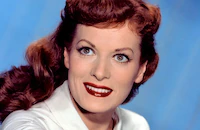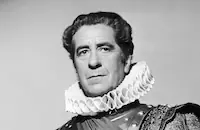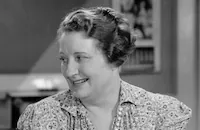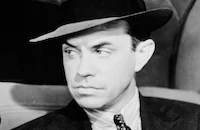A Woman's Secret

Brief Synopsis
Cast & Crew
Nicholas Ray
Maureen O'hara
Melvyn Douglas
Gloria Grahame
Bill Williams
Victor Jory
Film Details
Technical Specs

Synopsis
After singer Susan Caldwell, known to her fans as Estrellita, finishes one of her radio performances, she returns to her New York apartment, where she lives with her mentor, Marian Washburn. Susan and Marian immediately begin to quarrel when Susan declares that she is tired and wants to quit the business. A concerned Marian follows Susan upstairs, and a few moments later, a gunshot rings out and Marian is discovered by the maid, Mollie, bending over an unconscious Susan. Although Marian tells the police that she shot the singer, her admission of guilt is not believed by her longtime friend and sometime lover, Luke Jordan, a popular composer and pianist. Luke hires attorney Brook Matthews, Susan's ex-fiancé, to defend Marian. Flanked by Luke and Brook, Marian relates her version of events to Assistant District Attorney Roberts and police inspector Fowler: After following Susan into her room, Marian haranges her protegee about her career, demanding that she continue singing. When Susan states that she is returning to her former simple life, Marian shoots her with a gun that she later claims was a gift from an admiring soldier. Back in the police station, Marian concludes her story and is returned to her cell. Frustrated by Marian's passivity, Luke invites Fowler to lunch and tells him the story of how, years earlier, he and Marian met: In a New York café, Luke and Marian, a young, promising singer, perform together. Marian's career is about to take off when she develops a rare form of larnygitis. No longer able to sing at the level she is used to, Marian decides to give up performing. Later, Luke and Marian meet Susan when she faints from hunger after auditioning unsuccessfully for a Broadway show. Marian and Luke take Susan back to Marian's apartment and there learn that the pretty, unsophisticated girl from Azusa, California, has a voice "with hormones." Impressed by Susan's talent, Marian becomes her mentor and begins grooming her for a career in show business. After Luke concludes the first part of his story, he tries to see the heavily guarded Susan at the hospital. There he runs into Lee Crenshaw, a surly ex-soldier Susan met while performing in New Orleans, from whom Luke assumes Marian got her gun. Unable to talk with Susan, Luke goes to Fowler's home and, to the delight of Fowler's wife Mary, an amateur detective, continues his tale: Marian takes Susan to Paris, but as Luke later learns, Susan spurns her attempts at education and flees with a salesman to Algiers. Luke tracks the flighty, petulant Susan to an American nightclub in Algiers and there comes up with the idea of using the classic song "Estrellita" as her signature tune. Sometime later, while on board a luxury liner, Susan sings "Estrellita" to an appreciative crowd, which includes Brook Matthews and his mother. As Marian and Luke had hoped, Brook decides to use his money to promote Susan and soon falls in love with her. Back at the Fowlers', the detective remains unconvinced by Luke's testimonial, but Mary takes it upon herself to inspect Susan's apartment. While there, Mollie asks Mary to mail a Louisiana motel key that Susan had given to her just before she was shot. Later, while waiting at the hospital for Susan to recover from surgery, Lee reveals to Luke that he gave his gun to Susan, not Marian. When a groggy Susan confirms Marian's version of events, however, her mentor appears condemned until Mary shows her husband and Luke the motel key. Mary also points out that, shortly after Susan had left surgery, her nurse read aloud the newspaper account of the shooting, and thereby had influenced her memory. Confronted with the key, Susan admits that she married Lee in Louisiana, but quickly regretted her decision and fled to New York. Susan then recounts the moments leading up to the shooting: Upset about Lee, who has sent her a threatening telegram, Susan quarrels with Marian. When Marian reads the telegram and sees Lee's gun on Susan's vanity, she panics, believing that the singer intends to harm herself. Marian and Susan grab for the gun at the same time, and Marian accidentally shoots her protegee during the ensuing struggle. With the mystery finally unraveled, Fowler dismisses all charges against Marian. Susan then makes up with Brook, and Marian finally proposes to the faithful Luke.

Director

Nicholas Ray
Cast

Maureen O'hara

Melvyn Douglas

Gloria Grahame

Bill Williams

Victor Jory
Mary Philips

Jay C. Flippen

Robert Warwick
Curt Conway

Ann Shoemaker
Virginia Farmer

Ellen Corby
Emory Parnell
Dan Foster
Alphonse Martel
Eddie Borden
Charles Wagenheim
Marcel De La Brosse
Lynn Whitney
Rory Mallinson
George Douglas
Guy Beach

Lee Phelps
Mickey Simpson
Tom Coleman
Raymond Bond
Bill Purington
Bernice Young
Loreli Vitek
John Laing
Bert Davidson
Alvin Hammer
Frank Marlowe
Ralph Montgomery
John Goldsworthy
Frederick Nay
Forbes Murray
Donna Gibson
Evelyn Underwood
John Parrish
Oliver Blake

Paul Guilfoyle
Norman Nesbitt
Jack Rourke
Conrad Binyon
Ralph Stein
Robert Malcolm
Crew
C. Bakaleinikoff
James Barker
Jack Barron
S. H. Barton
Gordon Bau
Nacio Herb Brown
Charles Burke
Carroll Clark
Gordon Clifford
Doran Cox
Russell A. Cully
Albert S. D'agostino
George Diskant
William Dorfman
Frederick Hollander
James Kurley
Kay Lorraine
Herman J. Mankiewicz
Herman J. Mankiewicz
Harley Miller
M. M. Ponce
Clem Portman
Hazel Rogers
Frank Sarver
Dore Schary
Ollie Sigurdson
Darrell Silvera
Fae Smith
Edward Stevenson
Sherman Todd
Mercy Weireter

Photo Collections
Videos
Movie Clip



Film Details
Technical Specs

Articles
A Woman's Secret (1949) - A Woman's Secret
A Woman's Secret was a movie that had to be made, but not because of any urgency to its subject matter. RKO had to make it to justify paying a staff of designers and technicians and finish off a contract to borrow O'Hara from 20th Century-Fox. Moreover, with Grahame's recent hit as a sympathetic call girl in Crossfire (1947), the studio needed a suitable follow-up for an actress they hoped to promote to stardom. Finally, producer John Houseman had recently secured a studio position for Herman J. Mankiewicz, the writer with whom he had worked on Citizen Kane (1941). Generally considered unemployable because of his drinking and gambling problems, Mankiewicz was taking one last shot at success as the film's producer and writer.
The vehicle they chose to meet all these needs was a novel by Vicki Baum, author of the original Grand Hotel. As "The Long Denial," the film's original shooting title, the story had been serialized in Collier's magazine before being published as Mortgage on Life. Mankiewicz tried to shore it up with multiple flashbacks, including some depicting the same scene from different viewpoints (a device he had used in The Power and the Glory (1933), as well as Citizen Kane). But two of the flashbacks also lied, a gimmick Alfred Hitchcock would point up as a sure ticket to box-office failure when he tried it in his own Stage Fright (1950). And though the has-been singer in the novel was supposed to have lost her looks, RKO insisted on casting the amazingly beautiful O'Hara, changing the story so that it was the loss of her voice that had cost her stardom.
The first choice to direct this tangled tale was Jacques Tourneur, who had worked his way up from the studio's profitable Val Lewton unit, where he had directed such horror classics as Cat People (1942) and I Walked with a Zombie (1943). His moody, psychologically intense work, particularly on Out of the Past (1947), could have given the film a touch of style, but he turned it down - and so did Ray. Coming off his first film, They Live by Night (1949), which was generating buzz at the studio, he wanted a stronger project for his second film. But when he took a vacation after finishing his first picture, he came back ready to work on anything and allowed himself to be assigned the film. At least he could look forward to working with two of his favorite character actors -- Jay C. Flippen and Curt Conway -- whom he cast in small roles.
Ray kept the production moving at a good pace and even finished four days ahead of schedule. The main concern during shooting was O'Hara's low-cut costumes and provocative posing on camera. Leading man Melvyn Douglas would later say it was the only time he had found himself physically aroused while shooting love scenes. After a preview screening, Ray shot a new scene with Grahame, and then the film sat on the shelf for over a year. Howard Hughes had bought RKO Studios during the last days of production. Not only did he put the production through a number of different titles before settling on A Woman's Secret, but he then lost interest. By the time of its delayed release, Grahame had lost her career momentum, and the film lost almost all of its $853,000 budget. That marked the end of Mankiewicz's comeback. He would only have one more writing credit before his death in 1953.
A Woman's Secret brought Ray more than a box-office disaster, however. It also brought him a new wife. On the set, he and Grahame had developed an electric attraction to each other. He didn't really like her, he would later admit, but when he got her pregnant, he had to do the right thing. With his $5,000 bonus for completing the film and advances from RKO and his agents, the two went to Las Vegas, where they married a few hours after she secured a divorce from her first husband, actor Stanley Clements. The couple tried to make marriage work. Grahame even took time off from the screen to raise their son, Timothy, which may have contributed to A Woman's Secret's failure. In a curious footnote to movie history, the marriage ended partly because she had fallen in love with Ray's son, Tony, whom she would marry in 1960, thereby making Timothy his own uncle.
Producer: Herman J. Mankiewicz
Director: Nicholas Ray
Screenplay: Herman J. Mankiewicz
Based on the novel Mortgage on Life by Vicki Baum
Cinematography: George E. Diskant
Art Direction: Albert S. D'Agostino, Carroll Clark
Music: Frederick Hollander, Nacio Herb Brown
Cast: Maureen O'Hara (Marian Washburn), Melvyn Douglas (Luke Jordan), Gloria Grahame (Susan Caldwell), Bill Williams (Lee), Victor Jory (Brook Matthews), Jay C. Flippen (Police Detective Fowler), Robert Warwick (Roberts), Ellen Corby (Nurse).
BW-85m.
by Frank Miller

A Woman's Secret (1949) - A Woman's Secret
Quotes
Trivia
Nicholas Ray and Gloria Grahame were going through a marital separation during the soundstage filming of this motion picture, and for both professional and personal reasons kept this information from everyone in the cast and crew. Ray often slept on the set.
Notes
The working titles of this film were Mortgage on Life and The Long Denial. Modern sources note that RKO head Howard Hughes chose the final title. Vicki Baum's novel was serialized in Collier's magazine under the title The Long Denial between 1 June and June 22, 1946. A Woman's Secret marked producer/writer Herman J. Mankiewicz's first screen credit after a four-year drought. Although this film was shot after director Nicholas Ray's They Live By Night (see entry above), it was released before his debut picture. Ray married star Gloria Grahame on June 1, 1948. (Modern sources add that Grahame met Ray during this film's production and was four months pregnant at the time of their marriage.) Jay C. Flippen, who played "Inspector Fowler" in the picture, was Ray's best man at the civil ceremony, according to modern sources. Ray and Grahame divorced in 1952. A contemporary source indicates that Kay Lorraine dubbed Grahame's singing. RKO borrowed Maureen O'Hara for the production. Modern sources add the following additional information about the production: Jacques Tourneur was first assigned to direct the picture, but turned the film down because of scheduling pressures. After a preview of the film, Ray shot a new scene, featuring "Susan" in her hospital room. The film was budgeted at $853,000 and lost $760,000 at the box office.

Miscellaneous Notes
Released in United States Winter February 7, 1949
Released in United States Winter February 7, 1949













